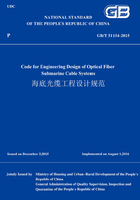
2 Terms and Symbols
2.1 Terms
2.1.1 Submarine repeater
Submarine optical signal amplifying equipment consisting of one or more regenerators or amplifiers and other related devices.
2.1.2 Repeatered submarine cable system
A submarine system that deploys submarine repeater(s).
2.1.3 Repeaterless submarine cable system
A submarine system that deploys no submarine repeater.
2.1.4 Beach manhole
A manhole set on the landing beach of submarine cable,used to terminate the submarine cable and connect it with land optical/power cable.
2.1.5 Cable landing point
The point where the submarine cable and the land cable are connected to each other,usually within a beach manhole.
2.1.6 Cable landing station
Terminal station of a submarine cable system,where SLTE,monitoring equipment and power feeding equipment may all be installed.
2.1.7 Sea wall
A wall built near the shore to block off sea water.
2.1.8 Segment
All devices,as a whole,of the submarine system between two adjacent SLTE connected to the same pair of fibers.
2.1.9 Anchorage area
A special designated area where ships may anchor.
2.1.10 Deep sea section
Submarine cable laid in areas where the sea depth is greater than 1,000m.
2.1.11 Shallow sea section
Submarine cable laid in areas where the sea depth is 20m-1,000m.
2.1.12 Inshore section
Submarine cable from the beach manhole to where the sea depth is 20m.
2.1.13 Landing section
Submarine cable from the beach manhole to where the sea depth is 5m.
2.1.14 Power feeding system
A power supply system that uses the loop formed by the earth and the power conductor in the submarine cable to provide power for submerged equipment.
2.1.15 Remote optical pumped EDF amplifier
A remote optical amplifier system consisting of a pumping source in the terminal equipment and EDF embedded in the cable line certain distance(usually 80km-120km)away from the terminal equipment.
2.1.16 Cable route desk top study
To propose one or more cable routes that are technically and economically viable based on the topological design of the submarine cable system and through collection and analysis of existing geophysical data,marine environment and marine development activities.
2.1.17 Route survey
Carrying out field survey for the cable route plans proposed in the cable route desk top study through geological sampling,geophysical survey,on-site observation,etc.,to ascertain the optimal route through comprehensive evaluation and comparison of information obtained,and to provide scientific and technical grounds for cable system design and installation.
2.1.18 Cone penetration test
A process where the cone probe is pressed into the soil at a constant speed to measure the penetration resistance(cone resistance,side friction resistance,etc.).
2.1.19 Optical coherent detection
To detect and receive the phase information of the carrier signal by conducting coherent mixing of local optical carrier and co-frequency carrier in the receiving equipment.